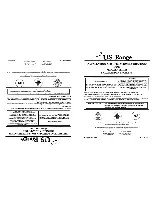
15
OPERATING INSTRUCTIONS
caUtioN
Water Will Be BoiliNG Hot.
The venting system should be inspected at the start
of each heating season. Check the vent pipe from
the boiler to the chimney for signs of deterioration
by rust or sagging joints. Repair if necessary.
Remove the vent pipe at the base of the chimney or
flue and, using a mirror, check for obstruction.
The lever of the pressure relief valve, shown in
figure #9
, on the boiler should be operated peri-
odically to make sure that it is functioning properly.
The pressure relief valve should open before the
water pressure exceeds the 30 lb. reading on
the gauge. If this pressure is exceeded and the
pressure relief valve leaks water when the boiler
is operating at normal pressures, it should be im-
mediately replaced. Corrosion can build up rapidly
at the valve seat and prevent its functioning as a
safety device.
sTarT-up and adJusTMenT of oil Burner
(See oil burner instructions for nozzle and electrode setting)
A. Check oil burner nozzle to make certain it is
tight in adapter. Burner mounting bolts should
be tight.
B. Check electrode setting, as they may have been
jarred out of position during transportation.
C. Lubricate burner motor and circulator motor if
required. Some circulators are water lubricated
and do not require oiling.
D. Set room thermostat to call for heat, or jump
thermostat contacts on the boiler control.
E. Open all oil line valves.
F. Turn service switch on. Burner should start.
G. On one pipe fuel systems only, vent pump as
soon as burner starts. Allow oil to run until all
traces of air in the suction line disappear.
H. Turn “OFF” burner and install pressure gauge
port on pump.
I. Start burner again and check oil pressure for
140 lbs. Adjust if necessary.
caUtioN
Do Not set Fire VisUallY
.
Instruments are the only reliable method to de-
termine proper air adjustments. An improperly
adjusted burner causes soot and high fuel bills
because of incomplete combustion of the fuel oil.
This in turn may require excessive boiler main-
tenance, service costs, and in some instances,
house cleaning or redecorating. A competent
service mechanic should be consulted to make
the proper adjustments with a smoke tester, CO
2
indicator and draft gauge. Bacharach or Dwyer
test kits include these instruments.
insTrucTions for proper operaTion
of The Boiler-Burner uniT
A ¼” diameter slot is provided in the inspection
cover plate to take draft readings in the combus-
tion chamber. See
figure #9
. A ¼” diameter
hole will be required in the flue pipe between the
boiler and barometric damper (if used) to take
draft, CO
2
, smoke and temperature readings.
Adjust air shutter on oil burner to obtain a “trace”
of smoke. Measure CO
2
at this point. Increase
air adjustment to lower CO
2
approximately one
(1) percent. Check to insure minimum negative
.02 w.c., (water column), “overfire” draft and zero
(0) smoke. If - .02 w.c. “overfire” draft can not be
maintained, changes and/or modifications may be
required in the venting or the chimney.
The following table (on next page) is provided as
a guideline for initial start-up. Final adjustments
MUST be made using combustion instruments as
previously mentioned.
Summary of Contents for SFM24150W
Page 2: ......














































